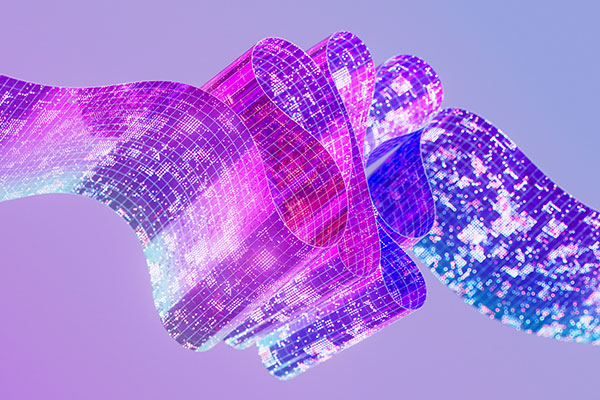Top tech investor: ‘Big Five’ stock concentration risk is justified
The share price success of the five biggest technology companies has increased their influence on the future direction of tech indices and global stock markets.
22nd July 2024 10:34
by Kyle Caldwell from interactive investor

Increasing levels of stock market concentration, brought about by the strong share price performances of a small number of US technology companies over the past 18 months, is a risk that’s justified, according to Ben Rogoff, who oversees investment trust Polar Capital Technology (LSE:PCT).
As part of Polar Capital Technology Trust’s annual results, which were published last week, Rogoff said at its year end (30 April 2024) that its three largest holdings – Nvidia (NASDAQ:NVDA), Microsoft (NASDAQ:MSFT) and Alphabet (NASDAQ:GOOGL) – represented 27% of its portfolio and 35% of its benchmark, which is the Dow Jones Global Technology Index. Its top five holdings, which includes Apple (NASDAQ:AAPL) and Meta Platforms (NASDAQ:META), represent 37% of its portfolio, and around 53% of its benchmark.
- Invest with ii: What is a Managed ISA? | Open a Managed ISA | Transfer an ISA
The biggest US technology shares have been on a strong run of performance over the past decade, barring 2022 when share prices came off the boil due to interest rate rises. However, since the start of 2023 share prices have accelerated again due to investor excitement over the potential for artificial intelligence (AI) to disrupt various industries. As a result, the so-called Magnificent Seven, which includes Amazon (NASDAQ:AMZN) and Tesla (NASDAQ:TSLA), account for nearly 30% of the S&P 500 index and around 22% of the MSCI World Index.
Last summer, the extraordinary performance of America’s largest tech stocks prompted a change in the make-up of one of the world’s most influential stock market indices. A “special rebalance” was carried out for the Nasdaq-100 index to make it less concentrated.
Rogoff says concentration risk remains “elevated” but is “justified”. He said: “We continue to believe that this concentration risk is justified because they are unique, non-fungible assets that capture the zeitgeist of this technology cycle and appear well positioned for AI given their significant scale advantages.
“That said, we remain unafraid of the idea of moving to materially underweight positions in the largest index constituents should we become concerned about their growth or return prospects, or should we find more attractive risk-reward profiles elsewhere in the market.”
- The passive fund risk investors need to be aware of
- Tech dominance keeps Fundsmith Equity trailing global markets
- Sign up to our free newsletter for share, fund and trust ideas, and the latest news and analysis
Apple, for example, was meaningfully reduced over the trust’s last financial year, Rogoff said. However, he remains positive overall on the big US technology stocks. “The timing of a more concerted move away from mega-caps remains highly uncertain, not least because in aggregate the stocks continue to enjoy strong relative earnings revisions while valuations remain far from ebullient,” he said.
As previously covered, technology dominance has increased concentration risk for passive funds – index funds and exchange-traded funds (ETFs) – tracking the sector. It has also created a more challenging environment for active funds to outperform.
To manage risk, Rogoff said he is unlikely to hold individual stock positions much above 10%. Instead, he says the focus is on “a diversified portfolio of AI-exposed growth stocks capable of outperformance, but also constructed to withstand investment setbacks, [which] should deliver superior returns over the medium term, particularly on a risk-adjusted basis”.
Over its financial year, Polar Capital Technology outperformed its benchmark in share price total return terms and net asset value (NAV) terms, up 50.5% and 40.8% versus 38.9% for the benchmark. The trust’s share price return was boosted by its discount narrowing during the year, from -13.4% to -7.4%. Share buybacks helped drive down the discount.
- Where to invest in Q3 2024? Four experts have their say
- Is there a perfect number of stocks for a portfolio?
- Watch our video: why these four UK shares are a hidden AI play
Commenting on AI, Rogoff said the theme is “just beginning”. He explained: “Where others may predict steady diffusion, we expect AI adoption to follow the pattern of electrification which was ‘sweeping and widespread’. For now, we (and the portfolio) are heavily focused on the companies helping build the AI ‘rails’: chips, systems, storage, networking. We believe these are the most direct beneficiaries of an infrastructure build-out that is only a few quarters old.”
Also of note in Polar Capital Technology’s annual results is a proposed 10-for-one share split to make the shares easier to trade, particularly for regular investors. Its share price is currently above £32. The share split will be subject to a shareholder vote.
These articles are provided for information purposes only. Occasionally, an opinion about whether to buy or sell a specific investment may be provided by third parties. The content is not intended to be a personal recommendation to buy or sell any financial instrument or product, or to adopt any investment strategy as it is not provided based on an assessment of your investing knowledge and experience, your financial situation or your investment objectives. The value of your investments, and the income derived from them, may go down as well as up. You may not get back all the money that you invest. The investments referred to in this article may not be suitable for all investors, and if in doubt, an investor should seek advice from a qualified investment adviser.
Full performance can be found on the company or index summary page on the interactive investor website. Simply click on the company's or index name highlighted in the article.